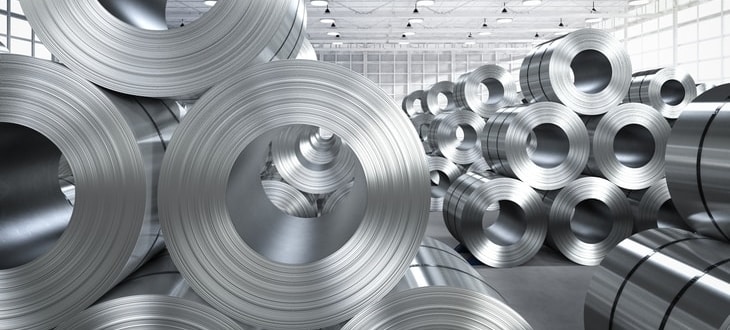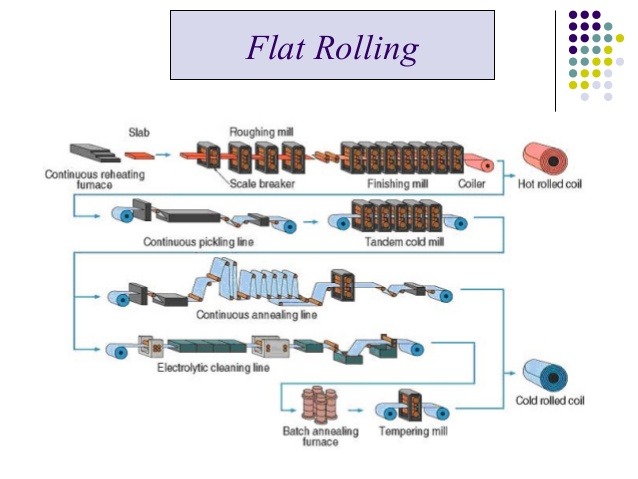So you want to use rolled steel in your project. If so, you may be wondering what type of rolled steel you should use. The terms “cold and hot rolled” refer to the industry names for steel formed at different temperatures. Today we’re going to discover the differences between hot rolled steel vs. cold rolled steel and the advantages that come with each.
What is rolled steel?
In metalworking, rolling is a process of forming metal into a final shape by passing through special machines that use heavy cylinders to flatten the metal into sheets. It’s very similar to rolling out dough with a rolling pin.
The rolling process is a key feature of most steel mills. Passing the metal material through pairs of roll stands that are grouped into rolling mills is how most steel factories shape metal into finished products. The rolling process can be used to create structural steel (l-beams, angle stock, channel stock), bar stock, and rails. There are many types of rolling like ring rolling, roll bending, roll forming, profile rolling, and controlled rolling that can be used depending on the desired shape.
The type of rolling used to create sheets of cold or hot rolled steel is called flat rolling.
What is hot rolled steel?
Hot rolled steel means that the steel has been roll pressed at temperatures over 1,700°F. When the metal is so hot, it’s easier to work with because it’s more malleable.
Steel mills start with a large mass of metal called a billet, which looks like a fairly long beam of metal. These billets are sent for pre-processing, where they’re passed through rollers and flattened into a sheet. After it’s flattened, the metal is white hot. This superheated metal is kept at a high temperature and then sent through finishing rolls where it will be smushed into its correct, final thickness.
The last steps will depend on what type of product this hot rolled steel is going to become. For sheet metal, that’s about all of the processing it has to go through. After it’s pressed to its final thickness, it’s rolled onto a coil and left to cool. If this steel is going to become bars, plates, or beams, then the metal is sectioned off and sent for additional processing.
Applications of Hot Rolled Steel
There are many different uses of hot rolled steel, including:
- Construction projects
- Pipes and tubing
- Doors
- Shelving
- Railroad tracks and car parts
Hot Rolled Steel and Its Unique Pattern
Hot rolled steel has something called a “scale”. It’s the scarring and marking pattern that is left on the metal after processing, which almost looks like it’s been burned and warped by the heat.
The reason why hot rolled steel has these markings on it is that the temperature is so high that it does not allow “recrystallization”. Recrystallization is a process where grains that have been damaged, as they are through the steel rolling process, are replaced with a new set of grains. This can only happen when the metal is cool, so any metalworking process that involves forming the metal in temperatures above the recrystallization point is considered “hot rolled”.
The key to rolling steel is to closely monitor the temperature while it’s being worked to ensure that it remains above the recrystallization temperature, otherwise the material will need to be reheated before being worked any further.
Matter expands when it’s really hot, and contracts when it cools. Because of this factor, the dimensions of hot rolled steel are not exact and can always change slightly as it settles after it’s cooled. This is something you’ll always need to keep in mind when opting to use this type of steel, as it may impact the success of your final work.
What is cold rolled steel?
Now that you understand what hot rolled steel is, let’s take a look at cold rolled steel and how this type of steel is created.
Cold rolled steel is created when you pass the steel through various rollers once it has cooled down from the initial production process. As it passes through these rollers, the steel will become thinner until it reaches its desired thickness.
This type of steel is generally stronger and harder than hot rolled steel. When the metal is shaped at a lower temperature, you’ll find that it’s much less likely to break due to tension and it’s more resistant to deformation. That being said, you need to compare both hot rolled steel vs. cold rolled steel for your unique needs, as one is likely to be the better option for your next project than the other.
Cold rolled steel is created for commercial steel and drawing steel, which is a more ductile type of steel. The main benefit of this type of steel when looking at hot rolled steel vs. cold rolled steel is that it has a lower carbon content. This means it’s extremely durable but can also be rolled to fit the dimensions you need for your project.
Cold rolled steel will usually have a matte appearance, which can be suitable for many different construction projects. If you do need to paint the steel, you’ll want to remove the lubricants that are often added to this metal before applying the color of paint you desire.
Applications of Cold Rolled Steel
These are a few of the most common applications of cold rolled steel:
- Household appliances
- Furniture
- Filing Cabinets
- Lockers
- Any application where precision is the top priority
Hot Rolled Steel vs. Cold Rolled Steel
The difference between hot rolled and cold rolled steel is this recrystallization point. Cold rolling is done when the metal is able to form “new grains” as the old ones are deformed by rolling and bending the metal.
Typically, mills take hot rolled steel after it’s mostly or completely cooled and work it to its final dimension by either rolling it, extruding it, or drawing the metal over a mandrel. For this reason, it’s usually referred to as “cold finished” in the industry instead of “cold rolled”.
When you cold work the steel, you can reduce its strength so a final step called annealing is added. In metalworking, annealing means heating the metal to 1,333-1,400°F which is just at the upper limit of the recrystallization point for steel. The metal is then allowed to cool very slowly, normally by leaving the metal inside the furnace and just switching the furnace “off” so it’s not brought to room temperature too quickly.
This process allows the metal to create a uniform microstructure, and reset its grain from the deformed heated grain back to something more closely resembling an “unheated” microstructure. It creates a metal that is very strong, but not too hard so it’s still easily malleable.
Which type of rolled steel should I use?
By considering these advantages and disadvantages of hot rolled steel vs. cold rolled steel, you can ensure you choose the right one for your next project. Both types of steel have great benefits when used in the correct application, and can help to offer you a strong and durable material for a variety of uses.
When choosing which type of rolled steel you want to use, there are many different factors to consider:
1. Cost
Because of the extra steps involved, and the increase in strength – cold rolled steel is more expensive than hot rolled steel.
2. Strength
Cold rolled steel is going to be stronger overall than hot rolled steel. Note that cold rolled steel has grains, while hot rolled steel does not. This is important because cold rolled steel is going to be strongest when it’s laid with the grain, and is significantly weaker against the grain. Because hot rolled steel has no grain, there is no difference in strength depending on its orientation.
3. The Construction Project
Another big factor in whether to use hot or cold rolled metal will depend on what construction processes you’re planning on using to affix the metal, and what function it’s going to play in your project.
4. Cutting Needs
If you’re planning on machining your materials further for your project, be very cautious with cold rolled steel. Cutting it the wrong way can cause warping, or otherwise damage the structural integrity of the metal if you’re not careful. This is a big contrast to hot rolled metal, which does not experience any sort of warping when machined because of its lack of grain. If you’re planning on welding, both hot and cold rolled metals will weld just fine – but keep in mind that cold rolled metal will take on the appearance and some of the other characteristics of hot rolled metal after being welded.
5. Appearance
The finish of cold rolled steel will be overall better than hot rolled, because of the mill scale that develops when it’s heated. Although, some people do like the look of hot rolled metal and have incorporated it on the exterior for design purposes.
Contact Tampa Steel for More Information on Hot or Cold Rolled Steel
This article illuminates the basic differences between hot and cold rolled steel. For more in-depth information, consult with experts in the steel field. The team of friendly professionals at Tampa Steel and Supply has decades of experience and can help answer any questions regarding rolled steel or other steel and metal concerns–from stainless steel sheets and pipes to sheet metal and aluminum tubing. Pick up the phone today to get a head start on your steel-related projects.
Request a Quote Online
Or Call Tampa Steel & Supply at (813) 241-2801


